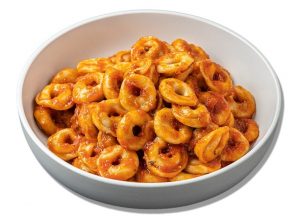Pasta is a nutritious food. There are a few reasons it’s good for you, including its low GI and fibre content. It’s also a great option if you’re watching your waistline. Bonus: pasta is easy to save for another day. It can also be used as a showcase for vegetables. It’s a great way to extend your meal time, so why not add it to your grocery list?
Nutritional benefits of pasta
Pasta Go Go is a common food usually made from an unleavened dough of wheat flour, eggs, and water, then shaped into strips or sheets. Then, it is typically boiled or baked. Pasta is an excellent source of protein, fibre, and iron. In addition, it is packed with vitamins and minerals.
 Unlike bread and other refined carbohydrates, pasta is cholesterol-free and is an excellent source of omega-3 fatty acids, which promote heart health. Pasta is also low in fat and has very little sodium, making it a good choice for people with diabetes. Furthermore, a single serving of pasta can provide 25% of your daily folic acid intake.
Unlike bread and other refined carbohydrates, pasta is cholesterol-free and is an excellent source of omega-3 fatty acids, which promote heart health. Pasta is also low in fat and has very little sodium, making it a good choice for people with diabetes. Furthermore, a single serving of pasta can provide 25% of your daily folic acid intake.
Pasta is rich in selenium, which helps protect cells from damage. It is also high in manganese, which helps the body metabolize carbohydrates. A cup of whole-wheat pasta has about 1.9 milligrams of manganese, while a cup of white pasta contains about half of that amount.
Pasta is a low-fat food, and its carbohydrates have been shown to boost brain function. This is because the brain is fueled by glucose, which pasta is rich in. It is also a great energy source crucial for physical performance. Athletes often eat pasta before the competition since it gives them a sustained energy source without the added fat. Moreover, pasta is cheap and easy to prepare.
Another factor contributing to the nutritional value of pasta Adelaide is that it is a good source of whole grains. Eating wholegrain pasta provides significant amounts of fibre and other nutrients that help your body stay healthy.
Its low GI
A low-GI pasta is a good option for those looking to reduce their glycemic load. The food does not cause blood sugar spikes and crashes and will help keep you feeling full longer. A low-GI pasta also contains fewer calories than regular pasta. Wholegrain pasta contains extra fibre, vitamins, and minerals.
The quality of the starch in pasta also plays a role in its GI level. The more pasta is overcooked, the higher the GI is. Overcooked pasta contains more starch, which is converted to glucose more quickly. Try to cook your pasta al dente, which is slightly chewy or firm.
The glycemic index, or GI rating, helps you determine whether a particular food is suitable for you or not. It measures how fast carbs raise blood sugar levels, and if the food causes high blood sugar levels, it can increase the risk of heart disease and diabetes. If you’re looking for low-GI pasta, you’ll be pleased to know that a wide variety is available.
Its fibre content
The fibre content of pasta can help you feel fuller for longer. Whole grain pasta has higher fibre and other nutrients than refined pasta, which means less calorie intake and less feeling of hunger after a meal. Wholegrain pasta also contains more fibre than refined pasta, which may help you lose weight more easily. A serving of cooked spaghetti typically contains 37 to 43 grams of carbohydrates.
Fibre helps balance blood sugar levels and lower cholesterol levels. Al dente pasta contains a special kind of fibre called resistant starch, which helps your gut lining stay healthy. Moreover, recent studies have linked adequate fibre intake with a lower risk of diabetes, heart disease, and some cancers.
There are many ways to get more fibre from pasta. You can choose wholegrain pasta, spelt pasta, and gluten-free pasta. By choosing wholegrain pasta, you’ll eat twice the amount of soluble and insoluble fibre. Whole wheat pasta also contains 20% more protein.
Its satiety
Pasta is an amazing way to keep calories down and increase your sense of satiety. Several recent studies have proven that pasta can help you lose weight and keep it off. Its fibre content can also help you avoid constipation. Plus, pasta is high in protein. This can be especially helpful for people who are trying to lose weight.
While the satiety of meat, dairy products, and processed foods is lower, they are still good choices as long as they are paired with other food sources, such as eggs, meat, or plant-based protein. Eggs are a versatile source of protein and are also low-calorie. However, they have a lower satiety score than non-starchy vegetables. This is because the yolk contains more vitamins and micronutrients.
In addition to pasta, you can also choose grilled fish or shellfish, both higher-satiety foods. Seafood is also a great option for those trying to lose weight because it helps you feel full longer. However, make sure to steer clear of deep-fried or breaded seafood. In addition, a visual guide to high-satiety plant-based foods is available.
While pasta may seem to be a great food choice for satiety, it is important to remember that different types of pasta will have different effects on your body. Whole nuts are high in fibre, which slows digestion and increases your feeling of fullness. Whole grains contain more fibre, which keeps your stomach full longer.
Another important factor to consider when choosing a food is its amount of protein. Protein helps you feel full by decreasing your hunger. Therefore, if you consume enough protein, you should be able to stop eating at a reasonable time.